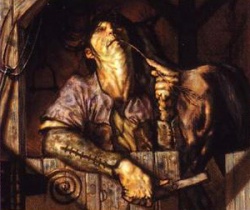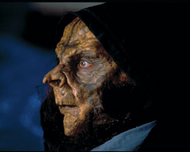
A Half-Orc
Half-orcs or Goblin-men were spies and warriors used by Saruman during the time he sought power in Middle-earth in the late Third Age.
Known as Goblin men, they were the servants of Saruman used in the old process of breeding Uruk-hai. Only once are they mentioned in the books. In The Two Towers ("Helm's Deep" chapter, during the Battle of the Hornburg), Gamling, a man of Rohan, refers to the army bred by Saruman as half-orcs and goblin-men.
Frodo quotes to the Fellowship upon leaving Bree "So that's where that southerner is hiding... he looks more than half like a goblin'' referring to the Squint-eyed Southerner, an outlaw from Dunland and agent for Saruman selling Pipe-weed."[1]
History
Half-orcs were usually the product of the union of Men and Orcs.[citation needed] They were not as wide spread as Uruk-hai, but they were still deadly. It is recorded that Half-orcs came to be by an evil act of sorcery where Saruman bred Dunlendings with the Uruk-Hai, the evil Half-orcs were the result of this union.[citation needed] The Half-orcs were slant eyed like orcs yet as tall as men.[citation needed] They worked in the deep caverns of Isengard for years preparing for Saruman's conquest of Rohan, forging weapons and armour. It is unknown if they were Immortal, or at least longer lived then Men. They were part of the armies of Saruman who attacked Rohan twice in the Battles of the Fords of Isen and of the 10,000 that attacked the Rohirrim in the Hornburg, were most of them perished at the Battle of the Hornburg, either before the fortress walls or in the Huorn's forest.
The rest of them were killed in the pits of Isengard, mostly because of the huge flood the Ents made when they descended upon Isengard with wrath.[2] Some lived beyond that day of doom and followed Saruman into exile, even during the Scouring of the Shire, where they served the fallen wizard with others until his last breath. In the Shire, they were all killed along with their fellow villains the Ruffians in the Battle of Bywater and buried in the Battle Pit.[3]
References
The first appearance of these half-goblins occurs in Fellowship of the Ring in describing one known as the Southerner, a spy of Saruman's;
In one of the windows he caught a glimpse of a sallow face with sly, slanting eyes; but it vanished at once. ‘So that’s where that southerner is hiding!’ he thought. ‘He looks more than half like a goblin.’[4]
Further description follows in the Two Towers.
But there were some others that were horrible: man-high, but with goblin-faces, sallow, leering, squint-eyed. Do you know, they reminded me at once of that Southerner at Bree; only he was not so obviously orc-like as most of these were.’[5]
In the Scouring of the Shire, there are further mention of the half-orcs under Sharkey's control, and they are described as men having squinty (or slanty) eyes and sallow complexion (a description used to describe the Southerner, Saruman's spy in Fellowship of the Ring, as well as some of the orcs in the Two Towers). Which seems to suggest that they look mostly human but share some of the features of the orcs.
they were disturbed to see half a dozen large ill-favoured Men lounging against the inn-wall; they were squint-eyed and sallow-faced. ‘Like that friend of Bill Ferny’s at Bree,’ said Sam. ‘Like many that I saw at Isengard,’ muttered Merry.[6]
‘Of all the ends to our journey that is the very last I should have thought of: to have to fight half-orcs and ruffians in the Shire itself - to rescue Lotho Pimple!’[7]
Portrayal in adaptations

A Goblin-man in the New Line film
In the film The Fellowship of the Ring Gandalf tells Elrond at Rivendell that Saruman has cross-bred orcs with goblin-men.[8]
References
- ↑ The Lord of the Rings: The Fellowship of the Ring
- ↑ The Lord of the Rings: The Return of the King
- ↑ Unfinished Tales: The Battles of the Fords of Isen
- ↑ J.R.R. Tolkien (2009-04-17). The Lord of the Rings (pp. 180-181). Harper Collins, Inc.. Kindle Edition.
- ↑ J.R.R. Tolkien (2009-04-17). The Lord of the Rings (p. 566). Harper Collins, Inc.. Kindle Edition.
- ↑ J.R.R. Tolkien (2009-04-17). The Lord of the Rings (p. 1004). Harper Collins, Inc.. Kindle Edition.
- ↑ J.R.R. Tolkien (2009-04-17). The Lord of the Rings (p. 1006). Harper Collins, Inc.. Kindle Edition.
- ↑ The Lord of the Rings: The Two Towers
